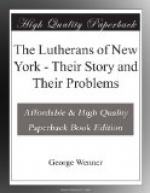With the help of his devoted wife, a night school was established. Additional schools became necessary. The Columbia Board of Education became interested and supplied the teachers while the mill company provided for the equipment. Mrs. Weltner helped the girls by creating an interest in good housekeeping and in beautifying the homes and their surroundings.
The movement extended to other parts of the state and into adjoining states, and Dr. Weltner was called upon to explain and direct it. The blind man had seen a vision. The homeless youth of New York’s East Side became the prophet of a new era who turned many to righteousness. His eyes now see the King in His beauty.
THEIR PROBLEMS
The Problem of Synods
A synod is an assembly of delegates organized for the purpose of administering the affairs of the churches they represent.
Fourteen synods are represented in Greater New York. Some are based on differences of doctrine. A volume published in 1893, entitled “Distinctive Doctrines and Usages” (See Bibliography), treats of these differences. Others are due to differences of language and race.
In some countries a hyperchurchly trend of the national or state church is responsible for dissenting movements which, left to themselves, finally take the form of separatistic churches. Although these movements temporarily persist in America there is no permanent need for them in our atmosphere of freedom. Our church has room for many men of many minds so long as the essentials of belief are held and respected.
Finns are represented in three synods, Scandinavians in four. These nations therefore account for one-half of our fourteen synods. The history of the Missouri Synod is one of struggle, sacrifice and remarkable growth. For seventy-five years other Lutherans have sought fellowship with them, but they decline to hold fellowship with churches that are not in full accord with their doctrinal position.
Each of these divisions has some historical reason for its existence which cannot be ignored or lightly pushed aside. For various reasons each synod emphasizes some phase of church life which in its opinion warrants a separate organization. Perhaps some of the progress of the last half century may be credited to a wholesome rivalry between these various schools of Lutheranism.
On the other hand these synodical divisions among churches holding the same substance of doctrine, even when they do not provoke downright hostility, are an effective bar to the fraternal alliance so greatly needed in our polyglot communion. Our neighbors, too, of other Denominations, when they try to understand our meticulous divisions, are not unnaturally disposed to look upon us as a conglomerate of sectarian religionists rather than as a Church or even as a distinct Denomination. In lists of denominational activities our churches figure as G. C. Lutherans, G. S. Lutherans, Missouri Lutherans, etc., while all of us are frequently called upon to explain whether we belong to the Evangelical branch of the Lutherans or not.




